Nakamura, Krush leading U.S. Chess
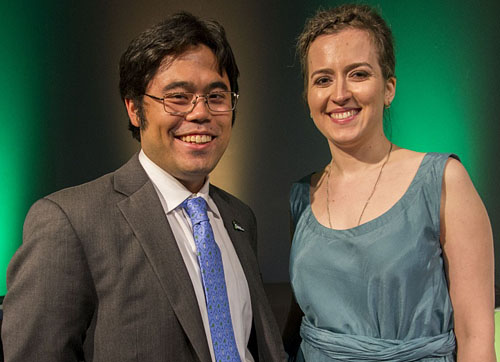
Hikaru Nakamura and Irina Krush…
2015 U.S. Chess Champions!
On a crisp Monday night of April 13th, Hikaru Nakamura and Irina Krush were crowned as the U.S. Champions. It would be the 4th for Nakamura and the 7th for Krush. It also reinforces the notion of where the power lies in American chess. While there is home-grown talent on the men’s side with Ray Robson, Samuel Shankland, Daniel Naroditsky, Conrad Holt, Kayden Troff and Samuel Sevian there is the ominous presence of Wesley So, the Filipino-born sensation who changed his federation with much fanfare last year. Uzbekistan-born Timur Gareev created moments of “reckless danger” for opponents.
Not to be outdone by the “young bucks” and “old heads” Gata Kamsky, Alexander Onischuk, Varuzhan Akobian, Nakamura showed his supremacy in positions where he had to be resourceful. While he was certainly critical of his play early on and was in a little trouble against So, he was able to avoid a major crisis and help stave off the heroics of aspirants. Robson had a breakout tournament and has shown that he will be a force in the future along with his friend Wesley So.
Irina Krush has continually shown she is a class above everyone else in American chess. One of only two full Grandmasters in the U.S., her nemesis IM Anna Zatonskih was not in the field and she was surely “missed”. However, there was fierce competition with newcomer Nazi Paikidze and Katerina Nemcova. In fact, Nemcova led for most of the tournament until her lost to Paikidze.
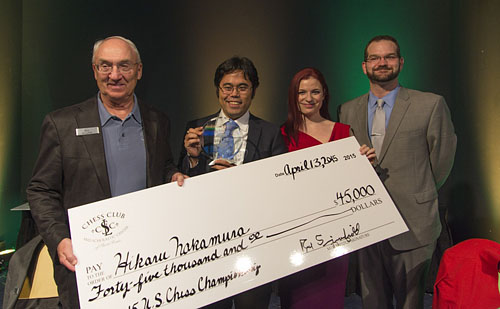
Hikaru Nakamura bagged his 4th title. His first was 10 years ago.
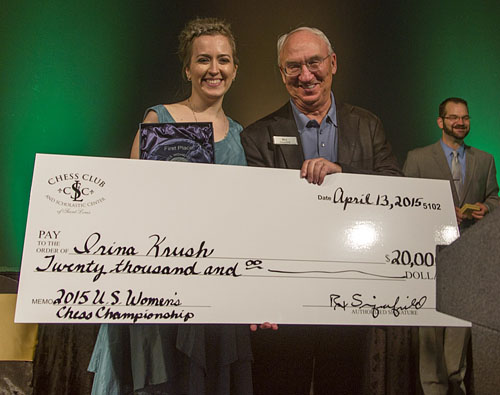
Krush is now a seven-time champion!
Photos by Lennart Ootes.
On the women’s side you have a number of emigres (past and present) who double as college students such as Sabina-Francesa Foisor, Nazi Paikidze, Katerina Nemcova and Anna Sharevich. You have two emigres in Rusudan Goletiani and Viktorija Ni who are involved in chess education. There were three juniors (Apurva Kirkud, Annie Wang and Jennifer Yu) and perhaps one of the quintessential role models for women’s chess, Alisa Melekhina, a newly-minted lawyer and entrepreneur.
What does the future hold for American chess? The scholastic aspect of chess has exploded and there are thousands of players developing from coast-to-coast. As more support is given to the efforts of Chess-in-Schools initiative, organizations like Chess Club and Scholastic Center of St. Louis and new events like Millionaire Chess, chess hopes to draw a higher profile. The environment may also give new players a chance to express their talents.
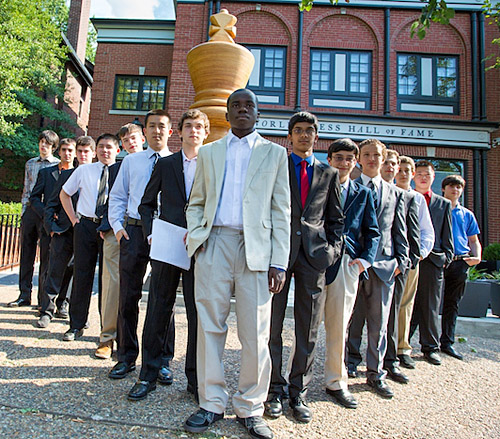
The future of American chess? Three of these 2012 Junior Closed participants competed in the 2015 U.S. Championship. Photo by CCSCSL.
Both Nakamura and Krush both came up through the American scholastic system and have turned into important figures in the American chess scene. One day they will be in the Hall-of-Fame. Young players are now emulating them and many project that the U.S. will remain as a world contender for Olympiad medals. At this point, Nakamura has a legitimate chance to compete for a world championship title and is now the #3 player. Is it time to start getting excited about the potential of another “boom” in American chess? Most definitely.
Official Site: https://www.uschesschamps.com/
Livestream: https://new.livestream.com/ccscsl/USChessChampionships
Chess24.com: https://chess24.com/en/watch/live-tournaments/us-championship-2015#live
Drum Coverage! https://www.thechessdrum.net/

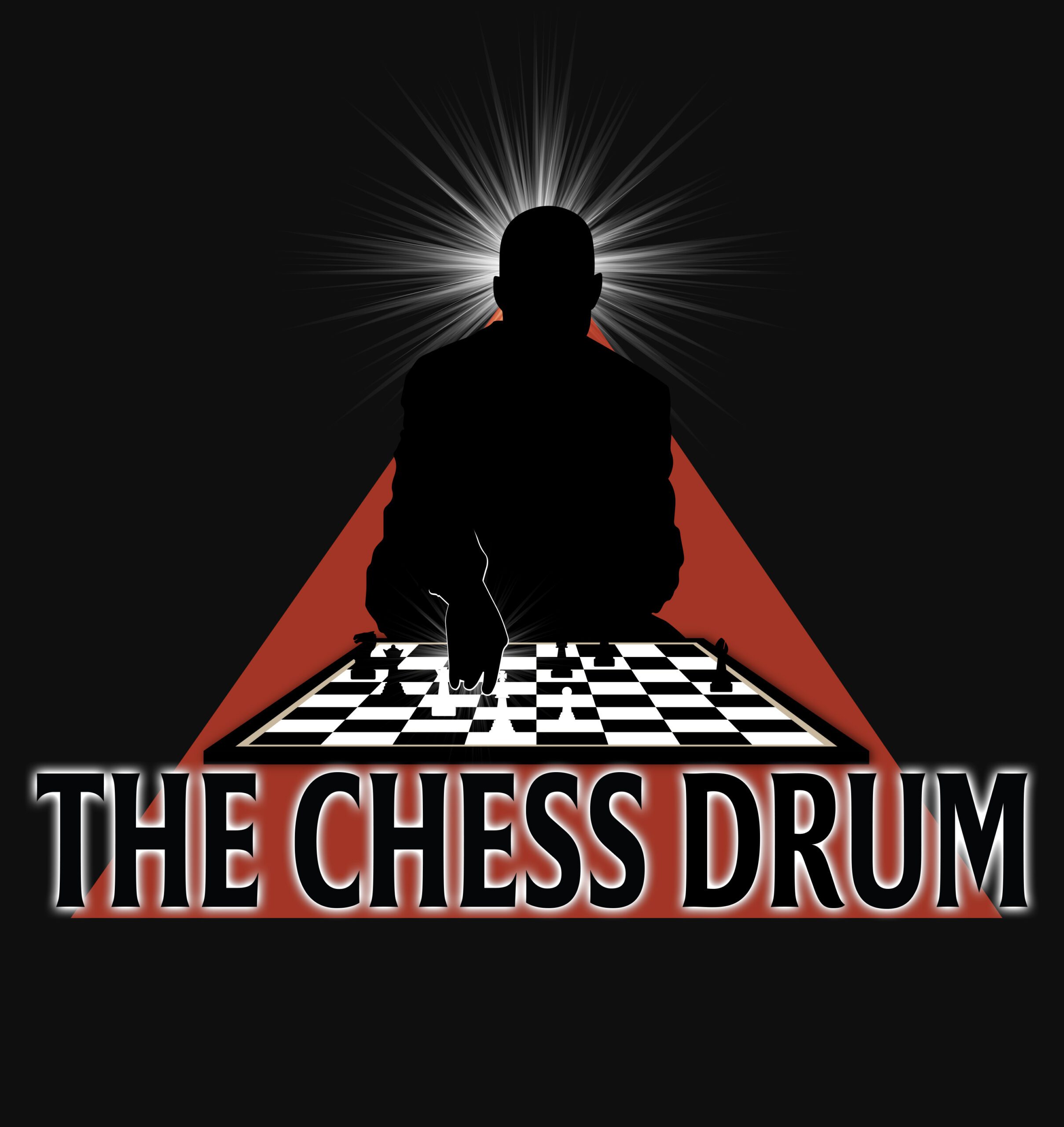
St. Louis, Missouri, USA
St. Louis, Missouri, USA
Several of the players in the 2012 U.S. Junior photo have already played in the U.S. Championship. Some featured are Troff, Naroditsky, Sevian and Holt. Who’s next?
That’s a good question, especially since the number of talented youngsters who are being trained to take over the helm of US Chess are few. I think to increase the pool, a serious effort to widen the selection of chess talent has to become a priority. With the small number of juniors who are shining it’s misleading to claim the future of US chess looks bright. For now, it looks like Akshat and the winner of the next US Junior Close will be the next one.
I believe three out of that bunch is good and that is not to mention a slew of others with your son included. Samuel Sevian wasn’t in that photo either, but he has catapulted into the limelight. Awonder Liang is not bad either. The amount of talent coming through the pipeline is immense. It remains to be seen whether it will translate into world-class talent. The first such collection of young stars was in the 50s and then the 70s and now forty years later. I remember we went about 10 years without producing a homegrown Grandmaster. There are so many young American-born GMs now. When Hikaru was coming up, he was the only one from a slew of juniors who made world-class, so numbers are not really goal.
In terms of what we had as compared to what we have today, I have to agree with you. But we can’t just focus on providing the best training to a handpicked few. That approach will only get us back to the days when you could count the number of star players. To a certain degree we should be aiming to produce as many IM and GM possible.
That’s the problem. U.S. Chess is not currently designed to produce IMs and GMs and there is no formalized structure. Few countries have a structure. In the U.S., players have become IMs and GMs primarily through their own means. Fortunately, you can play in a tournament in any state in almost any weekend and there are strong players to test one’s self. However, most of the players are left to find their own way.
There is little sponsorship in American chess which means you cannot fund these types of programs. The Chess-in-Schools is not really designed to produce titled players and programs like Kasparov School and Greg Shahade’s camp are not nearly enough. Not even the Samford Fellowship is sufficient since only one player gets it… and many times they are already GM-level.
Granted about 99% of scholastic players never get a chance to travel to World Youth or receive any type of coaching from a professional. Those who have had a chance belong to a select few. Out of those, you have the players who qualify for U.S. Junior Closed. They are even more elite. Out of those, you have a few who become GMs.
Whether there should be a focus on producing a lot of GMs or a few of the caliber of Carlsen, Nakamura or Caruana (top five) is the question. All of these players world-class solely because of parental support and not through any organized structure. The question is, what is the best way?
yeah some good talent here yet they still gotta lotta LEARNIN to do accordin to ULTRAMODERNISM but there are only two women gms in the U.S. why?
Only two women GMs… that’s a million-dollar question. No one has the answer.
Oh Thanks Daaim i wasnt aware of that fact until u mentioned it here on The Drum! Susan’s Birthday is today for all u Chessdrummers who dont KNOW, lol Shes a Louisian! i saw that at the Buffalo Public Library on the Internet the other day! hahahaha. oh Daaim as far as “No one has the answer” thats factually untrue and as an ULTRAMODERNIST its clear to me the reason for such a thing and it resides primarily with the limits and confines of Traditionalism itself, so Chessdrummers consider for a moment how the OLD CHESS could be the problem/issue and not the players at all. Lets say one of theses young ladies that just played in that practice event the U.S. Championship for example! DEUCES.
That is an accurate argument Daaim. I was under the impression that when we say the future of US Chess looks bright, it was our way of claiming that we are producing a good amount of titled players across the board. However, if the measure is based on how many kids are actually playing chess, then yes there is definitely a growing interest in chess in the US. I want to believe that the problem with not having a structure in place is due to lack of resources, but Is money really the issue?
Wow Daa’im, the United States went about 10 years without producing a home-grown GM?!? Just goes to show that producing GMs shouldn’t be expected to be automatic just because a given country is “trying”. If one looks at things in light of that 10-year American drought, it should temper the instinct to think of countries with less resources as underachievers– even if they are in the middle of a 20-30 year drought; which for some could be the entirety of their organized effort.
Oh thanks Patzer , wasnt aware of that.So How many gms would have to be produced in the U.S to be impressive? Im an ULTRAMODERNIST so im just curious? oh lil magasparov not a bad game today atall, vs Lagrave! Chessdrummers did yall see that game?
No… there was a long drought after the the rise of people like Joel Benjamin, Michael Wilder and Patrick Wolff. During that time was the dominance of the immigrants from the former Soviet Union. Now 30 years later new home-grown talent was helped in part because those immigrants have become coaches.